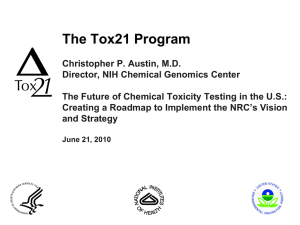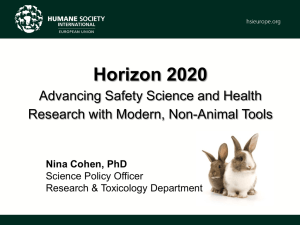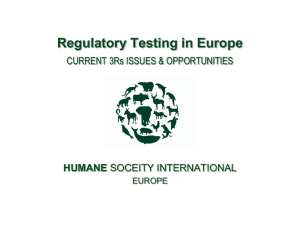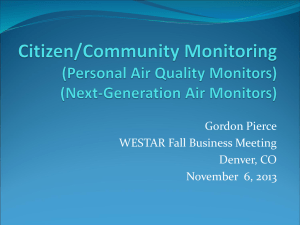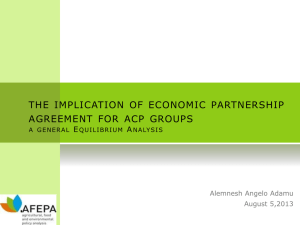Tox21 Phase I
advertisement
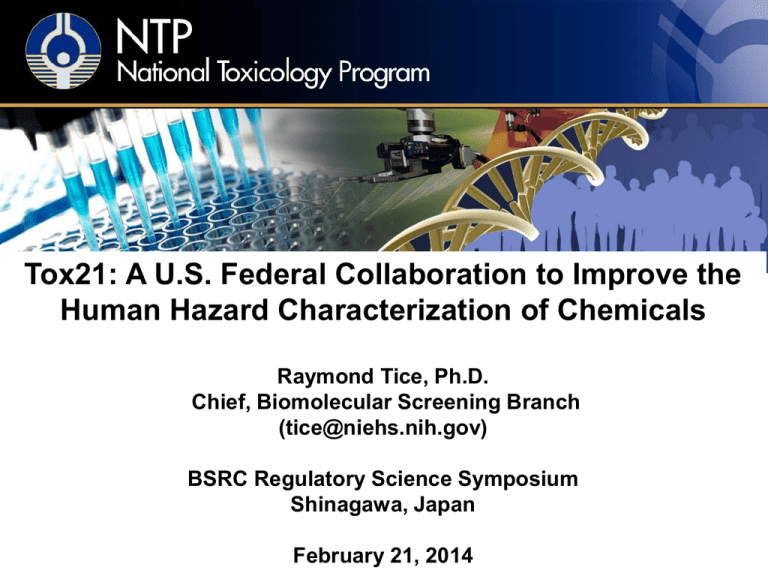
Tox21: A U.S. Federal Collaboration to Improve the Human Hazard Characterization of Chemicals Raymond Tice, Ph.D. Chief, Biomolecular Screening Branch (tice@niehs.nih.gov) BSRC Regulatory Science Symposium Shinagawa, Japan February 21, 2014 Topics • Background • Phase I – Proof of principle • Phase II - Expanded compound screening • Phase III - Improving on biological coverage and relevance • Chemical prioritization efforts 2 Our Need for Prioritization Too Many Chemicals Too Little Data (%) 9912 Judson et al., EHP 117:685-695 (2009) 3 Toxicity Testing in the 21st Century This 2007 National Academy of Science report envisions a not-so-distant future in which virtually all routine toxicity testing would be conducted in vitro in human cells or cell lines by evaluating perturbations of cellular responses in a suite of toxicity pathway assays using high throughput robotic assisted methodologies. 4 Activation of a Toxicity Pathway Exposure Tissue Dose Biologic Interaction Low Dose Higher Dose Higher yet Perturbation Normal Biologic Function Biologic Inputs Early Cellular Changes Adaptive Stress Responses NAS Report, 2007 Cell Injury Morbidity and Mortality 5 Formation of the U.S. Tox21 Community • • • 5-year Memorandum of Understanding (MoU) on “High-Throughput Screening, Toxicity Pathway Profiling, and Biological Interpretation of Findings” released on Feb 14, 2008 signed by NHGRI (F.S. Collins), NIEHS/NTP (S.H. Wilson), and EPA (G.M. Gray). Revised 5-year MoU to add FDA signed on July 19, 2010 http://ntp.niehs.nih.gov/go/28213) by NHGRI (E.D. Green), NIEHS/NTP (L.S. Birnbaum), EPA (P.T. Anastas), and FDA (J. Woodcock). Known informally as Tox21 for Toxicology in the 21st Century 6 Tox21 Goals • • • Identify patterns of compoundinduced biological response in order to: − characterize toxicity/disease pathways − facilitate cross-species extrapolation − model low-dose extrapolation Prioritize compounds for more extensive toxicological evaluation Develop predictive models for biological response in humans 7 Areas of Interest NIEHS/NTP NCATS EPA FDA Lab Animal Toxicology Human Toxicology/Exposure Assessment Ultra High Throughput Screening Low to Mid Throughput Assays Stem Cell Assay Development Epigenetic Assays Engineered Tissue Models ‘Omic Based Systems Lower Organism Models Genetic Variability in Response Databases & Informatic Tools Validation Experience 8 Agency Points of Contact FDA - Thomas Colatsky, Ph.D. NCGC/NCATS –Anton Simeonov, Ph.D. EPA/NCCT –Russell Thomas, Ph.D. NIEHS/NTP - Raymond Tice, Ph.D. Assays & Pathways Working Group Chemical Selection Working Group Informatics Working Group Targeted Testing Working Group Co-Chairs Kevin Gaido, Ph.D. (FDA) Keith Houck, Ph.D. (EPA) Kristine Witt, M.S. (NTP) Menghang Xia, Ph.D. (NCGC) Co-Chairs William Leister, Ph.D. (NCGC) Donna Mendrick, Ph.D. (FDA) Ann Richard, Ph.D. (EPA) Suramya Waidanatha, Ph.D. (NTP) Co-Chairs Ruili Huang, Ph.D. (NCGC) Richard Judson, Ph.D. (EPA) Jennifer Fostel, Ph.D. (NIEHS) Weida Tong, Ph.D. (FDA) Co-Chairs Michael DeVito, Ph.D. (NTP) David Gerhold, Ph.D. (NCGC) Timothy Shafer, Ph.D. (EPA) James Weaver, Ph.D. (FDA) Identify toxicity pathways & corresponding assays Establish compound Review nominated assays and prioritize for use at the NCGC Establish QC libraries for qHTS (10K, mixtures, watersoluble) procedures for compound identity, purity, concentration, and stability Evaluate assay performance Develop prioritization schemes and prediction models Make all data publicly accessible Evaluate relevance of prioritization schemes & prediction models Extrapolate in vitro concentration to in vivo dose 9 Tox21 Phase I – Proof of Principle (2005 – 2010) • EPA via ToxCast™ screened 320 compounds (309 unique, primarily pesticide actives and some endocrine active compounds) in ~550 assays. – • - Data made public via ACToR (Aggregated Computational Toxicology Resource; http://epa.gov/actor) NCGC screened 1408 compounds (1353 unique) from NTP and 1462 compounds (1384 unique) from EPA in 140 qHTS assays representing 77 predominantly cell-based reporter gene endpoints. Data made public via PubChem (http://pubchem.ncbi.nlm.nih.gov/) and will be available in CEBS (Chemical Effects in Biological Systems; http://www.niehs.nih.gov/research/resources/databases/cebs/) 10 Quantitative High Throughput Screening (qHTS) at NCATS • • • • • • • DMSO soluble compounds homogeneous assays 1536-well plate format 15-point concentrationresponse curve 5 nM to 92 M typical ~5 L assay volume ~1000-2000 cells/well 11 PhaseII qHTS NCGC qHTS Assays Tox21 Phase • Phenotypic readouts − − − − • • • • − Cytotoxicity Apoptosis: caspase 3/7, 8, 9 Membrane integrity: LDH, protease release • Mitochondrial toxicity (membrane potential) Genetox: p53, ATAD5, DNA damage repair deficient lines (chicken DT40 lines) Cell Signaling − Stress response: ARE, ESRE, HSP, Hypoxia, AP-1 − − Immune response: IL-8, TNF, TTP Other: AP-1, CRE, ERK, HRE, JNK3, NFkB Epigenetics − Locus DeRepression (LDR) Drug metabolism • CYP1A2, CYP2C19, CYP2C9, CYP2D6, CYP3A4 Target specific assays − Nuclear receptors: AR, AhR, ER, FXR, GR, LXR, PPAR, PPARδ, PPARγ, PXR, RXR, TRβ, VDR, ROR, RORγ − − hERG channel Isolated molecular targets: 12hLO, 15hLO1, 15hLO2, ALDH1A1, HADH560, HPGD, HSD17b4, APE1, TDP1, DNA polymerase III, RECQ1 helicase, RGS4, BRCA, IMPase, O-Glc NAc Transferase, Caspase-1/7, CBFβ-RUNX1, PK, Tau, Cruzain, β-Lactamase, PRX, YjeE , NPS, Proteasome, SF1, SMN2, beta-globin splicing, Anthrax Lethal Factor, TSHR Genetic variability: 87 HapMap CEPH Panel 12 Conclusions from Tox21 Phase I • qHTS can be used to screen libraries of environmental compounds against targets with known biological significance • Cell lines are more suitable for qHTS assays than primary cells • High quality data are essential for automated data analysis and interpretation - Signal to background ratio (S/B) - CV and Z’ factor - Reproducibility of duplicate compounds within and between runs • Biological relevance is critical: do the results make sense based on available standard toxicity test data and/or human data - Importance of reference compounds • Significant limitation remains the lack of hepatic metabolic activation Tice et al. EHP 121:756–765 (2013) 13 Tox21 Phase II – Expanded Compound Screening (2011 – 2014) • • EPA’s ToxCast™ Phase II: ~700 compounds in ~700 assays, ~1000 compounds in endocrine activity assays NCGC qHTS Phase II: – – 10K compound library screened 3 times at 15 concentrations in each qHTS assay qHTS assays focused on: • nuclear receptor activation or inhibition induction of cellular stress response pathways characterizing human variability in response Partner-lead projects – – – – cardiotoxicity (FDA) endocrine disruptors (EPA) genotoxicity (NIEHS/NTP) mitochondrial toxicity (NCATS) 14 Tox21 10K Compound Library 14000 12000 EPA (3726) 10000 8000 (1328) GSIDs 6000 Tox21 IDs 4000 wells (623) NTP (3194) 367 2000 (553) 0 EPA NTP NCGC Total NCGC (3526) Total Unique Library tested 3x in each assay Unique EPA NTP NCGC Total Total Unique GSIDs 3726 3194 3524 10444 8307 unique substances Tox21 IDs 3729 3210 3733 10672 10496 unique solution IDs wells 4224 3726 4224 12174 12174 total number of test cmpd wells 88 single-sourced cmpds in duplicate on each plate 2255 replicate substances (GSIDs) across 3 inventories Compound identity and structures available at http://www.epa.gov/ncct/dsstox/sdf_tox21s.html 15 Tox21 10K Compound Library NCGC • • • 3524 cmpds Drugs Active pharmaceutical ingredients EPA NTP • • 3726 cmpds • Antimicrobial Registration Program related compounds • Endocrine Disruptor Screening Program • OECD Molecular Screening Working Group List reference compounds from in vivo regulatory tests ToxCast I and II compounds • FDA Drug Induced Liver Injury Project • Failed Drugs •3194 cmpds •NTP-studied compounds •NTP nominations and •NICEATM/ICCVAM •External collaborators (e.g., Silent Spring Institute, U.S. Army Public Health Command) •Formulated mixtures 16 Phase II Stress Response qHTS Assays Oxidative stress ARE/Nrf2 in HepG2 P53 activation in HCT-116 colon cancer cells Genotoxic stress ATAD5 levels in HEK293 cells (ATPase family AAA domain-containing protein 5 – a DNA damage response element) DT40 (DNA-repair mutant isogenic chicken cell clones) (Rev3 (-/-), rad54/ku70 (-/-), wild type) pH2AX induction in CHO cells Heat shock Hsp70 in HeLa or HepG2 cells ER stress ESRE (lipid damage) in HeLa cells Hypoxia HRE (HIF-1α) in ME-180 cervical carcinoma cells Inflammation NFκB in ME-180 cells AP-1 activation in ME-180 or HepG2 cells Multiple stresses, cell death, specific toxicities Caspase 3/7 activation LDH release, ATP levels mitochondrial membrane potential in HepG2 cells hERG (ion channel effects) in U2OS cells (cardiotoxicity) Cell death/viability kinetic studies in 3 cell types *Bolded text indicates completed assays 17 Phase II Nuclear Receptor and Related qHTS Assays* hAhR full length receptor in HepG2 cells hAR full length receptor in MDA kb2 cells; partial receptor in HEK293 cells hERα full length receptor in BG1 cells; partial receptor in HEK293 cells hFXR partial receptor in HEK293 cells hGR full length receptor in HeLa cells hPPARδ partial receptor in HEK293 cells NR assays conducted in agonist and antagonist modes hPPARγ partial receptor in HEK293 cells hPXR full length receptor in HepG2 cells hRORγ partial receptor in CHO cells rTRβ full length receptor in GH3 cells; partial human receptor in HEK293 cells hVDR partial receptor in HEK293 cells Inhibition of aromatase using MCF-7 cells *Bolded text indicates completed assays 18 Tox21 10K Screen Performance Active match (%) Inactive match (%) AR-BLA agonist 5.4 86.9 7.4 0.3 1.8 89.6 AR-BLA antagonist AR-MDA agonist 15.5 4.1 75.1 93.7 9.4 2.2 0.1 0.0 1.4 1.4 96.4 99.7 AR-MDA antagonist 13.2 76.4 10.1 0.3 1.5 92.3 ERα-BG1 agonist 16.4 71.2 12.1 0.3 1.5 91.5 ERα-BG1 antagonist 12.0 79.7 8.0 0.3 1.5 95.3 ERα-BLA agonist 7.0 87.1 5.9 0.0 1.4 95.3 ERα-BLA antagonist 9.8 77.9 12.0 0.3 1.5 84.9 FXR-BLA agonist 2.5 93.9 3.7 0.0 1.5 95.1 FXR-BLA antagonist GH3-TRβ agonist 7.5 2.1 83.0 90.7 9.4 7.2 0.1 0.0 1.7 1.4 88.5 87.8 GH3-TRβ antagonist 17.2 68.4 14.2 0.3 1.4 87.8 GR-BLA agonist 6.7 87.5 5.8 0.1 1.4 94.9 GR-BLA antagonist 9.7 75.1 13.1 2.0 1.8 77.4 Assay Inconclusive Mismatch AC50 fold Score* (%) (%) *Score = 2x%active match + %inactive match - %inconclusive – 2x%mismatch 19 Tox21 10K Screen Performance (Continued) Assay PPARδ-BLA agonist PPARδ-BLA antagonist PPARγ-agonist PPARγ-antagonist VDR-BLA agonist VDR-BLA antagonist Aromatase AhR ARE ATAD5 DT40 (100) DT40 (653) DT40 (657) HSE-BLA Mitochondria Memb. Pot. P53-BLA Active match (%) Inactive Inconclusive Mismatch match (%) (%) (%) AC50 fold Score* 3.5 90.8 5.7 0.0 1.7 91.9 5.7 8.8 8.6 2.3 5.4 15.9 8.9 15.3 5.3 23.9 21.1 22.4 7.6 17.6 11.1 86.7 83.9 79.9 92.5 86.4 73.1 78.8 68.3 91.8 59.5 58.9 58.1 86.4 67.5 84.9 7.5 7.0 11.1 5.2 8.1 10.7 12.2 15.7 2.8 16.5 18.7 19.3 6.1 14.3 4.0 0.1 0.3 0.4 0.0 0.1 0.3 0.1 0.7 0.1 0.1 1.4 0.3 0.0 0.6 0.0 1.7 1.6 1.9 1.6 1.5 1.4 1.8 1.8 1.3 1.3 1.5 1.4 1.5 1.5 1.3 90.4 93.8 85.2 91.8 89.0 93.7 84.1 81.9 99.5 90.6 79.6 83.0 95.5 87.2 103.0 *Score = 2x%active match + %inactive match - %inconclusive – 2x%mismatch 20 NIEHS-NCATS-UNC TOXICOGENETICS PROJECT: qHTS for Cytotoxicity in a Population-Based in vitro Model Population-wide study design: Goal: use crowdsourcing to better predict the toxicity of chemicals 1086 1. Use the biological data (SNPs, basal gene expression) to develop a model that cell lines accurately predicts individual responses to compound exposure 2. Use the intrinsic chemical properties to develop a model that accurately predicts how a particular population will respond to certain types of chemicals 3. for information, go to https://www.synapse.org/#!Synapse:syn1761567 • To understand how genetic variation affects individual response to common environmental and pharmaceutical chemicals • The largest ever population-based ex-vivo cytotoxicity study – – – – – 1086 cell lines 179 common, pharmaceutical, or important environmental chemicals (9 duplicates) 8 concentrations (0.33 nM – 92 M) 1-3 plate replicates ~2,400,000 data points + 2-5x106 SNPs 21 Tox21 Phase II Advantages and Limitations • Extent of pathway coverage • Focus on the use of reporter gene assays using immortal cell lines • Focus on single compounds • Limited capability for xenobiotic metabolism • Focus on simple biological systems • Limited to acute exposure scenarios • Limited availability of “big” data analysis tools • Limited availability of high quality human toxicological data 22 Tox21 Phase III – Improving on Biological Coverage and Relevance (2013 - ?) • • • • • • Goal to develop more physiologically-relevant HepaRG Cells /predictive in vitro and lower organism approaches (models/assays/data interpretation strategies) to assess chemical toxicity potential Incorporation of xenobiotic metabolism & longer-term cumulative exposures into current and new approaches Increased use of in silico models and quantitative extrapolation models Integrated, data-rich assay approaches capturing various molecular pathways & cellular phenotypes Mechanistic studies integrating to Adverse Outcome Pathways (AOPs) Expand collaborations and interactions Spheroids/Organoids Near-Term Targeted Assays • High Content screening - Hoechst: Cell loss & nuclear size DHE: Oxidative stress/ROS p53: DNA damage pH2A.X: Genotoxicity JC-10: Mitochondrial damage (MMP) Caspase 3: Apoptosis Lipitox: Steatosis & Phospholipidosis Reactive metabolites/ROS: GSH depletion • Gene expression assays - ~1000 genes, multiple species 23 In Silico Analysis of the 10k Library for Xenobiotic Metabolism Identify Practicable Approaches for 10k chemicals • • Metabolite Structure Predictions (human enzymes) Extent of Metabolism Predictions (metabolic clearance) Assess Predictivity of Approaches • • • Assess accuracy via known substrates Do we predict true metabolites Assess extent of metabolism predictions Analyze 8,307 Chemical Structures (10k Library) • • P450 & UGT Substrate Predictions CLINT Predictions (combined via liver expression levels) Predict Metabolite Structures • Assess accuracy of metabolite structure predictions Assess Predicted Structures via QSAR models • • • Toxicity Predictions ADME/Permeabilities Physicochemical Properties Rank/Prioritize Chemicals for Assays in Metabolically Competent Model Systems • • • Predicted Toxicities via chemical structure alerts Extent of metabolism predictions Reactive Metabolites? QSAR Predictions Physicochemical •LogP, Lipinski Ruleof5, pH, solubility(water, salt,GI),blood/plasma ratio Human Metabolism •Substrate, inhibitor, CLINT, SOM, Metabolite Structures, ADME •Gut absorption & permeability, skin permeability, cornea permeability, blood-brain barrier permeability, uptake transport, efflux transport, Toxicity •22 QSAR model toxicity predictions •Human, Rat, Mouse, Aquatic •LD50, Mutagenicity, ALT, AST, Alk. Phos., LDH, phospholipidosis, reproductive, ER binding, AR binding 24 10k Library Xenobiotic Metabolism Predictions Substrate Calls Extent of Metabolism Predictions • CLINT predicted for 5 individual P450s • Combined CLINT from 5 Enzymes in ToxPi − Weighted each enzyme CLINT contribution by relative P450 expression levels #4 • 168,805 unique metabolites predicted • Evaluating ability to predict known metabolites in library • Assessing 10k library & 169k metabolites with various toxicity prediction models 25 High Throughput Transcriptomics Workshop On Gene Prioritization Criteria September 16-17, 2013 National Institute of Environmental Health Sciences 29 July 2013 Federal Register Request for Information • • The nomination and prioritization of ~1000 environmentally responsive genes per species for use in screening large numbers of substances in cells or tissues from human, rat, mouse, zebrafish, and C. elegans, using high throughput toxicogenomic technologies. Recommendations on criteria to use for prioritizing the genes that potentially would be the most useful in a screening paradigm, with a focus on effects that reflect general cellular responses, independent of cell type, and gene expression changes that are specific by cell type. 26 The NCATS BioPlanet: the universe of biological pathways for assay selection and prioritization • Hosts the universe of human pathways (~1600 unique) • All pathway annotations from manually curated, public sources (e.g., KEGG, WikiPathways, Reactome, Science Signaling) • Integrates pathways from >10 different data sources • Annotates pathways by source, biological function/process, disease/toxicity relevance, assay availability • Easy visualization, browsing, analysis of pathways • Facilitates pathway assay selection/prioritization for Tox21 production phase • Web version in process for public release From Ruili Huang, NCATS 27 Alternative Organisms – C. elegans and Zebrafish C. elegans (NIEHS/NTP) • Screened ToxCast Phase II compounds in growth assay • Screening subsets of compounds in assays that measure - feeding - larval lethality - reproduction Zebrafish – R. Tanguay (Sinnhuber Aquatic Research Laboratory, Oregon State University, Corvallis, OR) •Screened ToxCast Phase II compounds •Screening 3455 NTP compounds at ~ 64 μM •Assays include - 1 day photo induced behavior - 1 day assessment of mortality/developmental progression - 5 day photo motor response - 5 day assessment of 20 morphological endpoints 5 days 28 Human Stem Cell Related Projects • • • • • Collaboration with Cellular Dynamics and Molecular Devices to screen 80 compounds (focus on neurotoxicants, cardiotoxicants, mitochondrial toxicants) in: – Neurite outgrowth assay/mitochondrial membrane potential – Beating cardiomyocyte assay/mitochondrial membrane potential Collaboration with QPS, PhoenixSongs Biologicals, & the Hamner Institutes to evaluate biological activity of the 80-compound library in various human and rat neuronal cell culture systems (e.g., primary, embryonic stem cell–derived, induced pluripotent stem cellderived, transformed neural cell lines) Collaboration with XCell to characterize response of iPSC-derived neural populations (e.g., dopaminergic) from Parkinson’s disease (familial & sporadic) using the 80compound library Collaboration with the Buck Institution to screen the 80-compound library in hTERT astrocytic cell lines to identify senescence-inducing agents and verify results from the screen in primary human astrocytic cultures. Collaboration with the Univ. Konstanz to screen the 80-compound library in assays that evaluate migration of neural crest cells/neurite outgrowth in a human cell line. 29 NTP-CDI-Molecular Devices Stem Cell Project 30 In Vitro Neurite Outgrowth Assay Cell Body Processes (4) connected to cell body Branch 31 Tox21 Phase III • Greatly increased pathway coverage • Focus on high content screening using normal human cells • Focus is still on single compounds but increased interest in mixtures • Expanded capability for xenobiotic metabolism • Focus on more complex biological systems • Potential for more extended exposure scenarios • Expanded availability of “big” data analysis tools 32 BioActivity Network for Prioritization Data + = + 33 NICEATM Uterotropic Network Paint Uterotropic Actives Uterotropic Inactives 34 Filter for 1st Neighbors of Uterotropic+ Utero Actives Utero Inactives 1st Neighbors 35 Tox21/ToxCast Data Release Activities • Tox21 10K library data - Phase II data released in PubChem (86 entries to date at https://www.ncbi.nlm.nih.gov/pcassay?term=tox21) • On Dec 17, EPA publicly released ToxCast Phase II highthroughput screening data at http://www.epa.gov/ncct/toxcast/data.html - Data on 1,800 chemicals, screened in 700+ assays - Accessible via Chemical Safety for Sustainability Dashboards (http://actor.epa.gov/dashboard/) and raw data files - Release will include announcement of data challenges through TopCoder and InnoCentive to figure out how to use new data to predict chemical no effect levels. Winners will receive monetary prizes (http://epa.gov/ncct/challenges.html - EPA is hosting stakeholder workshops (information at: http://epa.gov/ncct/workshops.html 36 Success depends on • Robust scientific collaborations • Well-characterized chemical libraries • Well-characterized assays in terms of reliability and relevance, with broad biological coverage • Incorporating xenobiotic metabolism into in vitro assays • Informatic pipelines/tools that integrate and mine diverse data streams • Understanding the relationships between pathways and disease in humans and animal models • Making all data public • Outreach to the scientific community on the usefulness and limitations of Tox21 data 37 What will success bring? • Test methods for toxicity testing that are scientifically sound and more economically efficient • An increased ability to evaluate the large numbers of chemicals that currently lack adequate toxicological evaluation • Models for risk assessment that are more mechanistically based • Reduction and/or replacement of animals in regulatory testing 38
